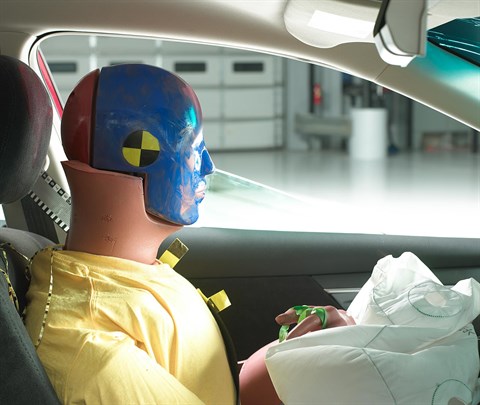Small overlap front: driver-side
Rating applies to 2013-15 models built after November 2012
Tested vehicle: 2013 Nissan Altima 2.5 S 4-door
The Nissan Altima was redesigned for the 2013 model year. Beginning with 2013 models built after November 2012, structural changes were made to improve occupant protection in small overlap frontal crashes. (Information about when a specific vehicle was manufactured is on the certification label typically affixed to the car on the driver door or adjacent B-pillar.) The tested car was built after the structural changes were in place.
| Evaluation criteria | Rating |
|---|---|
| Structure and safety cage | |
| Driver injury measures | |
| Head/neck | |
| Chest | |
| Hip/thigh | |
| Lower leg/foot | |
| Driver restraints and dummy kinematics | |

Action shot taken during the small overlap frontal crash test.

The dummy's position in relation to the door frame, steering wheel, and instrument panel after the crash test indicates that the driver's survival space was maintained reasonably well.

The frontal and side curtain airbags worked well together to keep the head from coming close to any stiff structure or outside objects that could cause injury.

The door hinge pillar began to tear as the wheel and tire was pushed back, and this intrusion contributed to a high risk of injury to the left lower leg.
Moderate overlap front: original test
Rating applies to 2013-18 models
Tested vehicle: 2013 Nissan Altima 2.5 S 4-door
The Nissan Altima was redesigned for the 2013 model year. Two moderate overlap frontal tests of the Altima were conducted, one by the Institute and the other by Nissan. Ratings are based on both tests.
| Evaluation criteria | Rating |
|---|---|
| Overall evaluation | |
| Structure and safety cage | |
| Driver injury measures | |
| Head/neck | |
| Chest | |
| Leg/foot, left | |
| Leg/foot, right | |
| Driver restraints and dummy kinematics | |

Action shot taken during the Institute's moderate overlap frontal crash test.

The dummy's position in relation to the steering wheel and instrument panel after the crash test indicates that the driver's survival space was maintained well (Institute test car shown).

Dummy movement was well controlled. During rebound, the dummy's head hit only the head restraint in each test, as indicated by smeared greasepaint in the Institute's test.

Intrusion into the driver's space was minimal in both tests, and all leg and foot injury measures were low.
Side: original test
Rating applies to 2013-18 models
Tested vehicle: 2013 Nissan Altima 2.5 SV 4-door with standard front and rear head curtain airbags and standard front seat-mounted torso airbags
The Nissan Altima was redesigned for the 2013 model year. Side ratings are assigned by the Institute based on a test conducted by Nissan.
| Evaluation criteria | Rating |
|---|---|
| Overall evaluation | |
| Structure and safety cage | |
| Driver injury measures | |
| Head/neck | |
| Torso | |
| Pelvis/leg | |
| Driver head protection | |
| Rear passenger injury measures | |
| Head/neck | |
| Torso | |
| Pelvis/leg | |
| Rear passenger head protection | |
Roof strength
Rating applies to 2013-18 models
Tested vehicle: 2013 Nissan Altima 2.5 S 4-door
| Overall evaluation | |
|---|---|
| Curb weight | 3,115 lbs |
| Peak force | 16,485 lbs |
| Strength-to-weight ratio | 5.29 |
Head restraints & seats
Seat type: Power cloth seats
| Overall evaluation | |
|---|---|
| Dynamic rating | |
| Seat/head restraint geometry |
About the head restraint & seat test
Currently, IIHS tests apply only to front seats.
